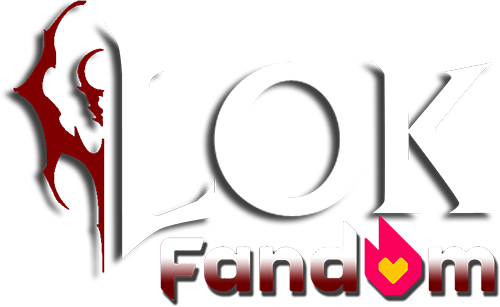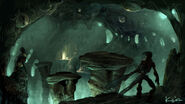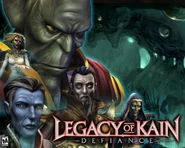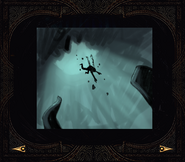The Elder God is a major character in the Legacy of Kain series, first introduced in Legacy of Kain: Soul Reaver, and returning in Soul Reaver 2 and Legacy of Kain: Defiance. Though initially a mysterious benefactor and ally to Raziel, the Elder God's portrayal becomes increasingly malicious as the series progresses. By the conclusion of Legacy of Kain: Defiance, he is regarded as the cause of "all of the conflict and strife throughout history", and as the central antagonist of the series as a whole.
Depicted as a sentient, writhing mass of tentacles and eyes dwelling deep below the land of Nosgoth, the Elder God claimed to be the hub of the Wheel of Fate, the preternatural cycle of birth, death and rebirth to which all souls were drawn. However, Raziel later accused the Elder God of merely being a parasite on the Wheel, not its hub. Although this was not confirmed or denied, a consistent fact was that the Elder God was sustained by the Wheel's turning. Thus, as vampires were immortal and their souls did not flow with the Wheel, they, and especially Kain, served as his greatest enemies.
Profile
Template:Qlisten
The Echoes of a Tortured Mind
Template:Qlisten

The Elder God addresses Raziel beneath the Lake of the Dead.
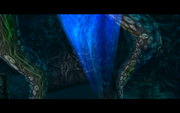
The Elder describes the Wheel of Fate and the demise of Nosgoth.
Dwelling simultaneously within the Spectral Realm, where time was described as irrelevant, and the Material Realm, where time flowed linearly, the Elder God was capable of interacting with other entities in a chronologically-inconsistent manner.[1] His enormous, cephalopodan form, typically shown submerged in subterranean water, appeared to thrive and expand in correlation with the decline of Nosgoth, and in the Soul Reaver era, his expanse occupied the Lake of the Dead. When the vampire Raziel was condemned for pupating beyond his master Kain, Kain ordered Turel and Dumah to cast his "prodigal son" into the Abyss at the heart of the lake.[2]
Though "an eternity passed" and the descent had effectively "destroyed" Raziel's body, he still "lived"; he awoke at the bottom of the lake, now a wraith inhabiting the Spectral Realm. The Elder God addressed him with familiarity: "I know you, Raziel. You are worthy". Raziel expressed petulant horror at his own "pitiful form", but the Elder chastized him, claiming he had "only spared [Raziel] from total dissolution". As Raziel listened, the Elder didactically explained the concept of the Wheel of Fate, and stated that the existence of immortal vampires imbalanced the world, preventing Nosgoth's souls from completing their destinies.
"For eons the Elder fed upon the souls of Nosgoth. Then Kain's vampire dynasty deprived the Elder of sustenance." The so-called God offered Raziel a "solution to [his] sorry existence"; if Raziel returned to the Material Realm and destroyed his former brethren, reaving their souls, he could exact revenge upon Kain. Intrigued, and lusting for vengeance against his former master, Raziel silently consented to this bargain, becoming the Elder's so-called "angel of death"; his "soul reaver".[2] Hereafter, the Elder and Raziel shared a symbiotic connection: whenever Raziel consumed a soul, the Elder would be satiated as well.[3][4]
There is Only the Now
Template:Qlisten
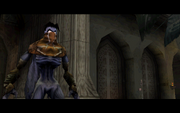
At the Sanctuary of the Clans, the Elder relates the story of Nosgoth's downfall.

The Elder confirms that Raziel was a member of the Sarafan in life.
By communicating symbiotically with Raziel, the Elder God introduced his new servant to existence as a devourer of souls. He mentored Raziel on the subjects of warp gates, soul devouring, Sluagh, planar portals and water, shepherding the wraith beyond the Underworld and into Nosgoth's barren wilderness. Raziel encountered unfamiliar, monstrous creatures; the Elder explained that these were devolved Dumahim, and, bemused by Raziel's disbelief, asked "do you suppose that time stood still for you, Raziel? Much has changed since you passed from the world of men".
Five centuries had passed since Raziel's execution.[5] At the Sanctuary of the Clans, violent tremors in the earth unsteadied him, prompting the Elder to explain that "this world is wracked with cataclysms – the earth strains to shrug off the pestilence of Kain's parasitic empire". He explained how Kain had refused to martyr himself to restore the Pillars of Nosgoth, and asserted that the world's "unraveling", invited by Kain's empire, had nearly played out. From that point onward, he usually only dispensed advice to Raziel following significant events, but would provide guidance if his counsel was solicited in the Underworld.
When Raziel battled and slaughtered Melchiah, the Elder congratulated him and dismissed his misgivings of fratricide, expressing that Raziel was "elevated" by consuming his brothers' souls. After Raziel fatefully claimed the Wraith Blade following his battle with Kain and the destruction of the Soul Reaver, he outlined the incorporeal weapon's uses, stating that Raziel had "liberated it from its corporeal prison, and restored it to its true form". At the Tomb of the Sarafan, he confirmed the revelation that Raziel was "born of the same force that all but destroyed [his] race", and freely volunteered the histories of the Drowned Abbey and the Ruined City. All the while, however, Raziel was left unwitting and ignorant of his true, inevitable destiny.
Deep in the Heart of this World
Template:Qlisten

The Elder's tentacles wrapped around the Pillars of Nosgoth.
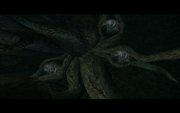
The Elder's amorphous mass in the Subterranean Ruins.
Raziel battled Kain in the Chronoplast below the Oracle's Cave, and pursued his destroyer through one of Moebius the Time Streamer's portals, believing that, by crossing the threshold, he would pass beyond the Elder's influence. He emerged in the Sarafan Stronghold of the much earlier pre-Blood Omen era, and, at first, encountered no evidence of the God's presence in this distant time period. However, while threatening Moebius in William the Just's chapel - when he uttered that "Death comes for us all" - the cowering Moebius said to him that "the Wheel of Fate demands it".
Taken by surprise, Raziel stayed his hand as Moebius confirmed that he, too, served the Elder God. The Time Guardian warned Raziel that "to strike me down would be striking God's own attendant, and I don't believe even you would take that risk". Disgusted by this new revelation, Raziel stalked away, spurning Moebius's pronouncements that he was "now most powerfully equipped to be [the Elder God's] agent - His instrument of restoration and retribution". He had already held a low opinion of Moebius from listening to Kain's tales, and this new information - that the infamous Guardian was allied to the Elder - instilled him with an intense distrust of both his co-conspirators.
In the Subterranean Ruins, the Elder God, his mass lodged in the waters deep below the Subterranean Pillars Chamber's surface and coiled around the Pillars, interrupted Raziel's study of the ancient vampire murals contained therein. The Elder condemned Raziel, who had just allowed Kain to escape him, and they bickered. Raziel questioned the Elder's candor and supposed omnipotence, unwilling to become his pawn. The Elder encouraged Raziel to kill Kain, reiterating his opinion of the vampires, and stated that "to embrace a serpent is to invite poison into your heart", but Raziel insisted that "if and when I kill him, it will be for me, alone, to decide".
In a Shroud of Righteousness
- "Merely the deceits of a failed civilization.
You are being misled, Raziel.
This Ancient race hoped to manipulate the future with these scrawled misdirections.
You must tread carefully.
There are dark forces at work in this world, bent on subverting your true destiny." - ―The Elder God[src]
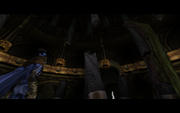
Encroaching upward, the Elder tried to obliterate the Pillars Chamber's muals.
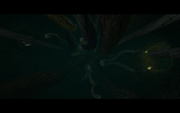
As Nosgoth's corruption intensified, the Elder appeared to thrive.
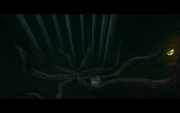
The younger, smaller Elder in Nosgoth's early history.
As he embarked on a journey to find Janos Audron, Raziel returned to the Elder God in the Pillars' grotto multiple times. Upon his return trip to the Stronghold after solving the Dark Forge, the Elder acerbically acknowledged him as his "wayward child"; Raziel replied that he had "unearthed more than you'd like". He queried the Elder on the ancients' ruins and murals, but the Elder dismissed them as "the deceits of a failed civilization", one which "hoped to manipulate the future with these scrawled misdirections". He warned that dark forces were at work in Nosgoth, bent on subverting Raziel's destiny, but Raziel vocally wondered, "am I in their presence right now?" Bristling, the Elder assured his rebelling servant that his reach was longer than Raziel appreciated.
The Elder God was next seen in the post-Blood Omen era, following Raziel's refusal to murder Kain at the Sarafan Stronghold, which altered history. Over a century after their previous encounter, Raziel was shocked to discover that the Elder's amorphous body seemed to be thriving, despite the chaos in Nosgoth following the collapse of the Pillars. The Elder greeted Raziel with disdain, branding him "the failed assassin" and condemning Kain's actions. His tentacles had wound up and around the Pillars' shattered stumps, in a "guilty scene" which prompted Raziel to wonder that "one would think [he'd] torn down the Pillars single-handedly".
Raziel commented on the Elder's possible motives, and his hunger for souls, disdainfully arguing that "the great adversary of the vampires turns out to be the biggest parasite of them all". Though the Elder threatened to "unmake" Raziel if he were so inclined, warning of "fates worse than death", Raziel mocked him, calling him a cancer; "a spooling parasite burrowed deep in the heart of this world". When they next conversed, while Raziel pursued the Sarafan commanders in Nosgoth's early history following Janos Audron's death, the Elder merely remarked with "ominous finality" that Raziel had failed him.
Embittered at having been "used by others time and again", Raziel called the Elder a "demon", speculating as to whether he had been responsible for his resurrection at all; whether, perhaps, he had simply been "dropped in [the Elder's] lair by Kain, indestructible for some reason. A durable and gullible tool for [him] to manipulate". He suspected by now that there was much more to his own history and destiny than either of them knew, but, whether disgruntled by Raziel's transgressions and accusations, or for other reasons, the Elder God seemed neither prepared nor willing to divulge any insight he may have had.
Here in Eternity with Me
Template:Qlisten
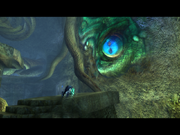
Raziel in the Underworld, in the Elder's captivity.
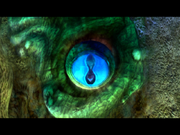
The Elder accuses Raziel of cowardice in the face of his destiny.
Raziel eventually realized the destiny the Elder God and others had apparently hidden from him; that he himself was the soul-devouring entity fated to become trapped within the Soul Reaver. Though Kain managed to postpone Raziel's fate by preventing Raziel from entering the blade, the ordeal weakened Raziel to the point of catastrophe, forcing him back into the Spectral Realm. He was next seen five centuries later in the Elder God's custody, trapped within the Underworld in the Blood Omen era.
When Kain attempted to interrogate Moebius in the caverns below the Stronghold, a few years after the slaughter of the Circle, he came upon the Time Streamer.[6] Unbeknownst to Kain, Moebius was secretly viewing Raziel's captivity in the Underworld, and apparently communing with the Elder via a shimmering pool. However, neither of them truly understood the Elder's nature, as Raziel did. The Elder starved Raziel of souls in an attempt to force him to relinquish his will, but - convinced that the Elder was a "voracious parasite" - Raziel refused to submit to his entreaties, preferring to suffer.
The Elder accused Raziel of "cowardice", understanding that his rebellion was partially motivated by fear of the Reaver; lingering in the Underworld, the wraith was able to indefinitely postpone his "inevitable doom". Unable to deny this truth, Raziel feigned submission to his master, and was rewarded with a soul. The Elder allowed him to progress through the Underworld, but he eventually made an attempt to flee the place in one of the area's tall caverns. Though the "displeased" Elder raised blankets of lethal mist and sundered the chamber's masonry with his limbs, he was unable to prevent Raziel's narrow escape.
In the Pointless Round of Existence
- "Surrender, Raziel. Abandon this petty rebellion. It was I who made you. Your life had played out, and in my grace, I spared you. You are my reaper of souls. You have no other purpose, no higher destiny – just this. Accept your calling, Raziel. Let go of these vain hopes. Relinquish your will, and feed."
- ―The Elder God[src]

Posing as the ancient vampires' oracle, the Elder speaks to Kain.
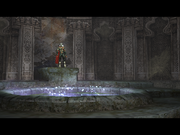
Kain emerges from the Elder's portal to the Blood Omen era.
After emerging in the Cemetery, Raziel came upon a planar portal allowing him to enter the Material Realm, but the Elder intervened; he used his powers to withdraw all such portals in Nosgoth, forcing Raziel to possess corpses to leave the spirit world. His restraints "had not been removed, only loosened". As he entered the Cemetery's courtyard, he was assailed by Archons - fellow agents of the Elder, "mindless hunters" which granted him a nightmarish vision of his master's ultimate plans for him. The Elder did not speak to him again for a considerable length of time, but his influence on Raziel's destiny did not end there.
When Kain succeeded in assembling the full Balance Emblem, he was able to enter a sealed chamber at the heart of the Vampire Citadel. A mural within depicted the ancient vampires' fall from grace, but, before he could examine it thoroughly, Kain was addressed by the Elder God's voice, emanating from a pool within the room. Kain was unaware of the Elder and his connection to Raziel, and heeded his claim; that he was the "Oracle of [his] ancestors", and that he could offer knowledge of Raziel. Though suspicious, Kain nevertheless felt it was imperative to reach Raziel, and passed through the temporal portal he generated to the Blood Omen era.
Before turning silent, the Elder spurred Kain to stop Raziel from obtaining the Heart of Darkness. Meanwhile, Raziel - exploring the Citadel's chambers in the Blood Omen era, and confronting the specters of the original Circle of Nine - began to unearth the mystery behind the ancient vampires' extinction. In the distant past, the ancients had righteously worshipped the Wheel of Fate and the unseen Elder God. The sterility and immortality imposed upon them by the Hylden blood curse led the Elder to abandon them, which drove them to madness, and mass suicide. Raziel felt that they, "the wisest, strongest, most noble race", had been "gulled by the voice of that old parasite".
With Ominous Finality
- "Despair, Raziel. There is no escape."
- ―The Elder God[src]

The Elder taunts Raziel in the Vampire Citadel's Spirit Forge.
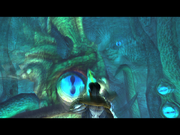
Moebius, purified, sees the Elder's true form for the first time.
The Avernus Catacombs proffered the Hylden side of the story; the "god-ridden and righteous" ancient vampires had started the Vampire-Hylden war, attempting to force the Hylden - who historically opposed the Elder God and the Wheel of Fate - into submission to his doctrine. As Raziel studied murals depicting the Hylden champion, he was contacted by the Elder, who affirmed his suspicion: that Raziel was this messianic figure. Kain believed that he himself was both the Scion of Balance and the vampire champion, and he and Raziel were aware that the champions were destined to fatefully destroy one another.
Raziel and Kain confronted each other in Avernus Cathedral, and Raziel was victorious, tearing the Heart of Darkness from Kain's chest. When he returned to Vorador's Mansion to resurrect Janos, ambivalently certain that he had "once again walked blindly" into his enemies' trap, Moebius awaited. The Time Streamer gloated that "for a true servant of the one God, death is never bitter", revealing that neither he nor the Elder had ever once been concerned over which of the champions either of them thought they were. Kain's death at Raziel's hands was all that had ever mattered to them.
Raziel resurrected Janos, who ratified the scraps of the ancient vampires' history he had uncovered. Raziel reacted with disgust when Janos spoke of the Elder reverently, referring to him as their God, and in the Spirit Forge, he was dismayed to see that the Elder's body infested the chamber. The Elder revealed that "it was Kain's destiny that mattered all along", and tried to extinguish the Spirit Forge's flame. Though Raziel solved the Forge and obtained the Spirit Reaver, he was soon returned to his former captivity with the Elder when the Hylden Lord destroyed his body in combat, shortly after the Pillars' collapse. The Elder had, at last, abandoned all pretense, taunting that "there is nothing more for you to do".
The Prime Mover Exposed
- "You cannot destroy me, Kain – I am the Engine of Life itself. The Wheel will turn... The plague of your kind will be purged from this world... And on that inevitable day, your wretched, stagnant soul will finally be mine."
- ―The Elder God[src]
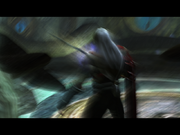
Kain, similarly, is purified, and perceives the Elder God.
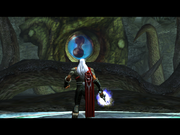
Kain prepares to do battle with the Elder, armed with the Soul Reaver.
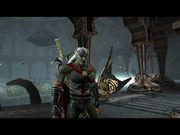
The Elder God threatens Kain as he leaves the crumbling Spirit Forge.
The Elder resurrected Moebius, who had recently perished at the hands of a younger Kain, and recalled his servant to the Forge.[7] They discussed the Hylden, whom Moebius referred to as "merely an inconvenient consequence" - "a small price to pay for Kain's death" - unaware that Kain had survived his ordeal in Avernus, and was about to slay him. As Moebius died, he indicated to Kain that he served "One who has power over life and death", sure that "all pain will fade, and [his] master [would] bring [him] life once more".
Moebius's spirit emerged in the Spectral Realm, beseeching his god, but unable to see him. Raziel suddenly impaled him with the Spirit Reaver, purifying Moebius's sight, and enabling him to see the Elder's form. Before Raziel devoured his soul, Moebius recoiled in profound horror at "the monster that [he] served". While the Elder dismissed his actions and Kain's return, Raziel reflected on his newfound knowledge. "All the conflict and strife throughout history, all the fear and hatred, served but one purpose – to keep [his] master's Wheel turning. All souls were prisoners, trapped in the pointless round of existence, leading distracted, blunted lives until death returned them – always in ignorance – to the Wheel."
Due to the Elder God's nature, "Moebius had never seen his master until the Soul Reaver purified his sight. Even the ancient Vampires had no idea what it was they so righteously worshipped." While the Elder God pulled violently at the Vampire Citadel's foundations, Raziel attempted to "end this". He used Moebius's corpse as a vessel to enter the Material Realm, and was impaled by an unwitting Kain on the Reaver. Kain tried to prevent Raziel's sacrifice again, but Raziel - dispersing the Wraith Blade into Kain's body - purified Kain's sight, finally enabling him to see "the true enemy" before being consumed to create the Soul Reaver.[3]
Aghast at the monstrosity that was revealed to him, Kain agonized: "had I condemned Raziel to this nightmare when I cast him into the abyss"? The Forge tumbled as he challenged the Elder God with the newly-empowered Soul Reaver, dealing him spectacular damage for the first time in his existence. Kain taunted that "you would not fear us unless we could truly do you harm". Flailing in fury and agony as Kain proceeded to escape the collapsing chamber, the Elder impotently assured him that he could not be destroyed, but that Kain's death was inevitable. Despite his threats and the menace he still posed, Kain was unfazed. Looking out upon Nosgoth in silence, he knew now that "the strings of the puppets had become visible, and the hands of the prime mover exposed".
- "In the meantime, you'd best burrow deep."
- ―Kain[src]
Template:Icon-NosgothApocrypha
Although it is not directly named, the Elder God does appear to have some role in the cancelled spin-off Nosgoth set in the mid-Soul Reaver era, where it seems to inspire some degree of worship among the humans of the age, with few having a clear or unified understanding of what they worship. Shrines often show many-eyed faces and amalgamations of tentacles and marine creatures. Dieties that appear to be inspired by the Elder God include "the Seagrave", "the Salt Lord", "the Saint of Dark Waters" and "the Drowning God" worshipped by the Drowning Men - which is illustrated as a tentacled skull on cosmetic items and other icons.[NOS][8]
Development
Development
Concept sketch of the Elder's eyes in Legacy of Kain: Defiance.
Legacy of Kain: Defiance concept art of the Elder in the Spirit Forge.
The Elder God has been voiced by Tony Jay in all of his appearances. Since Jay's death in 2006, his performance as the Elder has been cited as one of his most memorable roles in video gaming.[9][10] Jay had previously voiced Mortanius in Blood Omen: Legacy of Kain, prompting players of Legacy of Kain: Soul Reaver to speculate that there was a connection between the two characters, and Hash'ak'gik.[11][12][13] This possibility was encouraged by series director Amy Hennig in a 1999 interview, but sequels did not pursue it.[14] In Legacy of Kain: Defiance, both the Elder and Mortanius appeared, with Jay voicing the Elder and Alastair Duncan voicing Mortanius. Hennig explained that "Tony has a great voice, but it's always clear that it's him, and the intention was not to make The Elder God and Mortanius sound the same".[7]
The Elder God and the Wheel of Fate were thematically derived from the real-world concept of the Demiurge in a branch of pre- and early-Christian religious thought named Gnosticism. In this system, "the cosmos is ruled by a malevolent "pretender" god, [and] humans are prisoners in a spiritual lie" - "the fundamental idea is that the physical world is inherently corrupt, a tyranny of lies ruled by a false creator god". Under the Gnostic philosophy, "the material world is an illusion, a lie perpetrated by a false and malignant god whose aim is to keep the human soul in darkness and ignorance".[15][16][17] Horror writer H. P. Lovecraft's Cthulhu Mythos, and, especially, the characters of Cthulhu and Shub-Niggorath, also served as influences.[18][19]
A pre-release brochure for Legacy of Kain: Soul Reaver makes mention of a feature which did not appear in the final version of the game: "Raziel can recruit other vampires to the Elder's cause".[20]
In the originally-conceived storyline of Legacy of Kain: Soul Reaver, Raziel was to succeed in destroying Kain, eliminating the last of Nosgoth's vampires by traveling to the Pinnacle of the Silenced Cathedral and unleashing a "hymn of death" across the land.[21][22][23] "Only then would he realize that he'd been the Elder God’s pawn all along, that the purging of the vampires had devastating consequences, and that the only way to set things right would be to use Moebius' time-streaming device to go back in time and alter history (in the sequel)." During the development of Soul Reaver 2, the series' story was reconceptualized, but "arrived at a similar place, just by a different route"; the Elder God still evolved into an antagonist.[15]
Additionally, some dialogue recorded for the Elder was altered or cut between pre-release builds of Legacy of Kain: Soul Reaver. Of particular interest is an early version of his interaction with Raziel at the Sanctuary of the Clans: this iteration had Raziel say "damn you! How many ages did you bind me in your grasp"? The Elder God was to reply "a millennium, or a moment? We who stand outside the rim of time dwell not in past or future ages; there is only the now". In this build, the "earthquake" part of that sequence was moved to the following cutscene at the Lake of the Dead.[24][25] An unused voice sample also features the Elder describing the history of the Oracle's Cave (Raziel does so in the final game).[24][26]
As of the ending to Legacy of Kain: Defiance, the Elder God remains alive, and was to return in cancelled sequel Legacy of Kain: The Dark Prophecy.[27] Legacy of Kain: Defiance was planned to feature a final chapter, in which Kain would travel to the Soul Reaver era to destroy the Elder God, and hence restore Nosgoth, before returning the Soul Reaver to its proper point in time. However, this was never produced, and no final battle with the Elder was designed.[28][29] Series artist Daniel Cabuco has since disclosed his own ideas for such a confrontation: "Raziel's cycle was complete, Kain was given a chance at hope, and the Elder God, though defeated, was set up to be an adversary in the next game. Except.. there was no next game. LOL. If Kain were to ever defeat the Elder God, I am sure it would require the restoration of the pillars and somehow 'pinning him down' before finishing him off with some Epic use of the Soul Reaver. It could be a level or the intent of a whole game to beat him, involving multiple locations where you track him down and destroy key areas that he dwells in or uses as anchors to keep himself in our world. In any case it shouldn't be a single encounter or small thing to beat him..."[30]
Interviews have elaborated on the Elder's behind-the-scenes involvement in the Legacy of Kain backstory. In 2001, Hennig and Chris Bruno revealed that the large statue in Soul Reaver 2's Subterranean Ruins is "a symbolic representation of the Elder God fashioned by an ancient, primitive cult".[31] In 2003, the origin of his relationship with Moebius was revealed: "Moebius was introduced to the Elder God when he lived among the Vampires of the Citadel. The Elder God spoke to him even after he stopped communicating with the Vampires. The human revolt was orchestrated through Moebius by The Elder God".[7] The Elder was responsible for enabling Moebius to obtain his staff.[32] Cabuco has also indicated that the ruins in the Underworld in Legacy of Kain: Soul Reaver are the remains of the Lost City, pulled into the Abyss by the Elder.[33]
According to sources in Climax Studios, the storyline of the cancelled sixth game project, Legacy of Kain: Dead Sun, "revolved around The Elder God. Religion was one of the game's overarching themes".[34]
Appearance
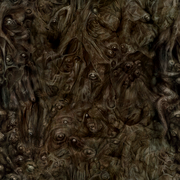
The Elder God's body texture in Soul Reaver 2.
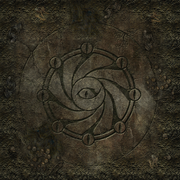
Legacy of Kain: Defiance texture of the Elder's symbol.
The Elder God is consistently portrayed as a cephalopod-like mollusc creature, and was directly referred to as "a giant squid" by Raziel. Daniel Cabuco was responsible for designing the Elder God, who - in Legacy of Kain: Soul Reaver - was "one of the last things [he] made for the game, yet one of the first things everyone sees". He was given a short brief to extrapolate from: "the Elder God was described to me as a series of eyes and tentacles, so I did some research to look for themes to tie together. Spirals were a big part of the game, so I decided to make a series of spirals with eyes at their center that grew and overlapped each other. Crinoid fossils were also a big influence. Basically I just had fun making eyes and finding ways to tie them together with spiral tentacles, octopus suckers, and benthic fossil records".[35]
In Soul Reaver 2 and Legacy of Kain: Defiance, the Elder's body appears more frequently and prominently than in Legacy of Kain: Soul Reaver. He consists of innumerable flickering eyes and contorting tentacles of varying sizes, his colors range between pigments of green and brown, and his voice is disembodied. When riled or injured, his eyes noticeably dilate and quiver. Fossilized shellfish adorn his skin structure. In Legacy of Kain: Defiance, the Elder's eyes bear the infinity sigil, a callback to the one on Moebius's forehead which first appeared in Blood Omen: Legacy of Kain. Legacy of Kain: Defiance introduces another symbol for him, emblematic of the Wheel of Fate which he controls.
The Elder's mass is enormous, occupying a huge expanse of territory stretching (at least) to encompass the caverns beneath the Cemetery, the Lake of the Dead, the Pillars of Nosgoth and the Vampire Citadel by the Soul Reaver era.[36] As the aeons pass and he siphons more energy from souls, he thrives and grows incrementally larger. Beings native to the Material Realm could not typically see the Elder's body, including his worshippers; Raziel could distinguish it after being remade as a wraith, and Moebius and Kain became able to perceive it as well following their purification by the Spirit Reaver. Upon being wounded by the Soul Reaver, the Elder's eyes and tentacles weep his "lifeblood" - green soul energy.
Personality
Fundamentally devious, deceptive and wrathful, the Elder God's "origins are shrouded in mystery, and few in Nosgoth even know of [his] dark existence".[37] His "subtle influence reaches across the length and breadth of the land", and Raziel characterized him as "something primal", "angry", "righteous" and "ancient".[2][37] Little is revealed of his personality in Legacy of Kain: Soul Reaver, aside from his captaincy of the Wheel of Fate and stark hatred of Kain and Nosgoth's vampires, whom he describes as "abominations", an apostate "scourge", and a "parasitic curse". In Soul Reaver 2, his relationship with Moebius sows seeds of suspicion in Raziel, who begins to rebel against him. In response, the Elder begins to impart the first of many false, over-embellished accounts of his stature, role and power.
Soul Reaver 2 depicts the Elder's rising wrathfulness in the wake of Raziel's rebellion. In the post-Blood Omen era, his tentacles are apparently attempting to obliterate the ancient vampires' murals, probably in a bid to erase the last vestiges of that culture's existence, and prevent others from unearthing his connection to it. He is pompous, pretentious and rhetorical, constantly assuring Raziel of his power and appealing to him to destroy Kain. Early in Legacy of Kain: Defiance, he upholds the pretext that destroying Kain will restore Nosgoth, but, as soon as Kain is defeated by Raziel in Avernus Cathedral, drops this façade. He deems Raziel's fate "trivial", and declares that "there is nothing more for [Raziel] to do" - this affirms the idea that he is a manipulative, deceitful being, prioritizing self-preservation over the health of the world - ironic, for he lays the same accusations against Kain when tempting Raziel to kill him. Raziel highlights the Elder's profuse self-aggrandizing tirades in the Spirit Forge, bitterly quipping that he was "beginning to think the Vampires committed suicide only to escape [his] voice".
All of the Elder God's agents and worshippers, apart from the mindless Archons, were victims of his deception, and he discarded each of them when their use to him had "run its course". His known disciples, Janos Audron and Moebius, both regard him as a benevolent deity; Janos relates how the ancient vampires' "immortality banished them from God's grace - He turned His sight from [them], and fell silent. Many took their own lives, unable to bear the separation from [their] God". Moebius venerated him, but, in Soul Reaver 2, Raziel ponders that Moebius's faith might falter if he told him "that he’s worshipping a giant squid". In Legacy of Kain: Defiance, the answer is revealed when Moebius "sees the horror of the Elder God at last". Kain, on first perceiving the Elder, immediately regards him as an enemy, a "nightmare", and a "false god".
Powers
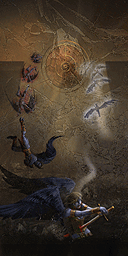
A depiction of the Elder God's Wheel of Fate.
Although the Elder's status as a true god becomes more dubious as the series continues, he is an incredibly powerful entity. He is somewhat atemporal, describing himself as omnipotent - "eternally present – here and everywhere; now and always" - existing in both the Material and Spectral Realms simultaneously, and interacting with others in a manner which is not chronologically linear.[1] Sustained by soul energy, he has commanded a variety of underlings throughout history, including the ancient vampires, the Archons, Moebius, Raziel, and - so he claims - "more malleable servants". He possesses incredible strength, able to use his tentacles to smash through walls and floors, even being able to drag the Spirit Forge underground. Furthermore, he is telepathic, allowing him to mentally communicate with Raziel regardless of their proximity, and converse with others through oracular pools.
The Elder controls the Wheel of Fate, the natural, spiritual cycle of inevitable life and death within Nosgoth. Though he claims to be a benevolent force - "the origin of all life" - he is actually a parasitic creature who somehow established a link with the Wheel, bleeding souls to sustain his own insatiable hunger.[38] His symbiotic agents feed him with the energy of any souls they consume.[4] Manipulating the Wheel, he can resurrect the deceased at will, provided their souls have not already been devoured, and revives Moebius in Legacy of Kain: Defiance.[7]
The question as to whether or not the Elder was truly involved in Raziel's resurrection, raised in Soul Reaver 2, remains unanswered in the games. Amy Hennig addressed the matter as follows: "was Raziel correct in his accusations in his final confrontation with the Elder God? When people hear the dialogue, it's important to remember that just because a character says something, it isn't necessarily correct. What you're hearing is that character's opinion and subjective interpretation. So if you mean: "did Raziel just drop into the EG's lap by coincidence, or did the EG have something to do with his resurrection?" Let's just say Raziel doesn't know everything yet, and neither do we".[39] Daniel Cabuco gave more definitive answers:
Template:Quotebox-Opaque
Template:Quotebox-Opaque
Other magical abilities at the Elder's command are seen in Legacy of Kain: Soul Reaver and Legacy of Kain: Defiance. He is capable of summoning force fields and temporal portals, and possesses supreme control over the planar portals of the Spectral Realm; in Legacy of Kain: Defiance he retracts all such portals from Nosgoth. When confronted by Kain, he conjures a protective shield of force to defend himself, and issues blasts of blue soul energy which hone in on his foe. According to Amy Hennig, the Elder can be attributed to the disappearance of Reaver fonts in Nosgoth following Soul Reaver 2. For Legacy of Kain: Defiance, she "wanted to include a cutscene or artwork indicating that the fonts had been destroyed, implying that the Elder God had pulled them under or caused them to be destroyed in some other way, but it didn't fit in the final game".[7]
Etymology
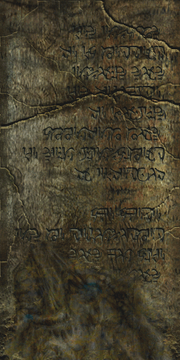
The Elder God's name in a Lovecraft's Diary inscription.
No given name has ever been attributed to the character, and the Elder God is never even formally referred to under this title in other characters' dialogue exchanges. The "Elder God" name is derived from a variety of other direct and supplementary official sources, including the games' bonus materials, dialogue scripts, casting credits and Prima guides. Within the Legacy of Kain universe, a Lovecraft's Diary floor texture in the Underworld from Legacy of Kain: Defiance also utilizes this moniker for the character.[40][41] In Legacy of Kain: Soul Reaver's manual, Raziel simply refers to him as "the Elder", while at one point in Soul Reaver 2, he names the creature "Old One", in apparent reference to the Cthulhu Mythos.[2]
Moebius regards the Elder only as his master, and as "the one God". Legacy of Kain: Defiance introduces two alternate titles for the character; the ancient god, and the oracle of the ancient vampires. In the same game, Kain scorns him as a "false god" and "the prime mover", metaphorically controlling Nosgoth's inhabitants like puppets. The Elder God himself makes use of more bombastic titles when asserting his own role, naming himself "the Engine of Life", "the origin of all Life", "the devourer of Death", "the circle of life and death" and "the hub of the Wheel". However, both Raziel and Kain express their rejection of these claims in the course of the story.
The Elder's true gender is ambiguous. Though Moebius, Janos Audron, Raziel and many supplementary materials refer to him as male, the stage directions of the Dark Chronicle scripts in Soul Reaver 2 universally use neuter pronouns in reference to him. It may be that, as a "divine" or otherwise unconventional entity, the Elder can validly be described as asexual, despite his masculine voice.
Notes
- In an early scene in Legacy of Kain: Soul Reaver, the Elder God explains the earthquake which rattles the earth at the Sanctuary of the Clans as a cataclysm caused by Kain's parasitic empire. However, given the new context of his true motives and powers in Legacy of Kain: Defiance, it is plausible that the Elder himself simply triggered that earthquake to influence Raziel against Kain.
- One of the Elder God's descriptions of himself in Soul Reaver 2 - "the still center of the turning wheel" - is an almost verbatim quote from the poem Burnt Norton, part of T. S. Eliot's Four Quartets collection. In Burnt Norton, whose narrator attempts to relate an abstract description of time and eternity, "the still point of the turning world" is a central line. Amy Hennig has confirmed that T. S. Eliot was a major thematic influence on her entries in the Legacy of Kain series.[15][17]
- Each time Raziel approaches the "center" of the Elder God at the Subterranean Pillars Chamber in Soul Reaver 2 (in either the Material or Spectral Realms), the Elder will speak to him, issuing a taunt from a small pool of quotes. His sound bytes become increasingly sinister as Raziel progresses through the game (new quotes are added in each era).
- The origins and long-term motives of the Elder God are never revealed in the series, nor in extraneous interviews and materials. Daniel Cabuco has suggested that this should remain the norm, saying that "the Elder God is a constant. [...] I don't think we need to try and lay out his motivations.. that would just make him less epic of an enemy."[42] However, Cabuco has postulated on his ultimate goal: "killing Kain meant the ultimate collapse of the Pillars, bringing the Hylden back. That's an entire race to feed a very hungry parasite. The more death the Elder could create, the more souls he could leech off the wheel. his influence would be almost irrestistable [sic] and he would dominate the Spectral Realm. With the Hylden slaughtering the Vampires, or perhaps stalemating with some of the surviving Bosses (depending on when Kain died), he would have one fat war to feed on".[43]
Gallery
See also
- Template:Icon-Wikipedia The Elder God at Wikipedia.
- File:Wiki-Icon-DC.png The Elder God (The Oracle of the Ancient Vampires) at Dark Chronicle (by Marie Tryhorn).
- File:Wiki-Icon-TLW.png An Alternate Introduction at The Lost Worlds (by Ben Lincoln).
- File:Wiki-Icon-TLW.png A Return to the Soul Reaver era at The Lost Worlds (by Ben Lincoln).
References
- ↑ 1.0 1.1 File:Wiki-Icon-DC.png The Elder God (The Oracle of the Ancient Vampires) at Dark Chronicle (by Marie Tryhorn)
- ↑ 2.0 2.1 2.2 2.3 Cite error: Invalid
<ref>tag; no text was provided for refs namedSR1-Manual-US - ↑ 3.0 3.1 Template:Icon-Eidos Answers to questions from the Defiance team at the Eidos Forums (by Chris@Crystal)
- ↑ 4.0 4.1 Template:Icon-DCab So many questions at DCabDesign (by Luke27), post #10 (by Daniel Cabuco)
- ↑ Template:Icon-GS Blood Omen 2 Q&A at GameSpot (by Sam Newman)
- ↑ Defiance Sarafan Warrior at spectraljin.com (by Daniel Cabuco)
- ↑ 7.0 7.1 7.2 7.3 7.4 File:Wiki-Icon-TLW.png Question and Answer with Amy Hennig at The Lost Worlds (by Ben Lincoln)
- ↑ Template:Icon-Nosgoth'The Sacred and the Profane' at the Nosgoth official blog (by Chris 'Oghamsmith' Murphy) (preserved at Square Enix Nosgoth official forums/Tales of Nosgoth)
- ↑ Template:Icon-1UP Voice Actor Tony Jay Dies During Surgery Recovery at 1UP.com (by Patrick Klepek)
- ↑ Template:Icon-Kotaku Video Game Voice Actor Tony Jay Dies at Kotaku (by Florian Eckhardt)
- ↑ Template:Icon-NR Mortanius and the Elder God at Nosgothic Realm (by Innocent omniscient)
- ↑ Template:Icon-NR Possible Endings for SR2 at Nosgothic Realm
- ↑ Template:Icon-NR Turel...The Elder is....TTWND at Nosgothic Realm (by Infinite daremo)
- ↑ Template:Icon-NR GLoK Interviews with Amy Hennig at Nosgothic Realm (by Raziel Fan)
- ↑ 15.0 15.1 15.2 Behind the Classics: Amy Hennig Talks Soul Reaver Secrets at the PlayStation Blog (by Sid Shuman and Amy Hennig)
- ↑ Template:Icon-NR GLoK Interviews with Amy Hennig at Nosgothic Realm (by Raziel Fan), post #4 (by RazielFan)
- ↑ 17.0 17.1 Template:Icon-IGN The Influence of Literature and Myth in Videogames at IGN (by Douglass C. Perry), page 3
- ↑ Template:Icon-IGN The Influence of Literature and Myth in Videogames at IGN (by Douglass C. Perry), page 2
- ↑ Template:Icon-DCab Kain's next move at DCabDesign (by Kain_Fan), post #13 (by Daniel Cabuco)
- ↑ File:Wiki-Icon-TLW.png Early Versions of The Story at The Lost Worlds (by Ben Lincoln)
- ↑ File:Wiki-Icon-TLW.png The Final Battle with Kain at The Lost Worlds (by Ben Lincoln)
- ↑ File:Wiki-Icon-TLW.png The Pinnacle of The Silenced Cathedral at The Lost Worlds (by Ben Lincoln)
- ↑ File:Wiki-Icon-TLW.png Opening the Sounding Pipes at The Lost Worlds (by Ben Lincoln)
- ↑ 24.0 24.1 Cite error: Invalid
<ref>tag; no text was provided for refs namedSR1-Deleted - ↑ File:Wiki-Icon-TLW.png An Alternate Introduction at The Lost Worlds (by Ben Lincoln)
- ↑ File:Wiki-Icon-TLW.png Soul Reaver Technical Information (Overview) at The Lost Worlds (by Ben Lincoln)
- ↑ Template:Icon-DCab 3 quick questions at DCabDesign (by Jake Pawloski), post #4 (by Daniel Cabuco)
- ↑ File:Wiki-Icon-TLW.png A Return to the Soul Reaver Era at The Lost Worlds (by Ben Lincoln)
- ↑ Template:Icon-DCab Defiance question at DCabDesign (by Liquid Yarullin), post #4 (by Daniel Cabuco)
- ↑ Template:Icon-DCab Defiance question at DCabDesign (by Liquid Yarullin), post #2 (by Daniel Cabuco)
- ↑ Template:Icon-Eidos Chris@Crystal's Greatest Hits at the Eidos Forums (by Divine Shadow)
- ↑ Template:Icon-DCab Moebius's Staff at DCabDesign (by Cradlis), post #2 (by Daniel Cabuco)
- ↑ Template:Icon-DCab The Connection between the Lost City and the Abyss at DCabDesign (by Jake Pawloski), post #2 (by Daniel Cabuco)
- ↑ The 10 Cancelled Legacy of Kains (Mama Robotnik Research Thread) at NeoGAF (by Mama Robotnik)
- ↑ Template:Icon-DCab Concept question at DCabDesign (by Strands of Night), post #2 (by Daniel Cabuco)
- ↑ Template:Icon-NR Maps (Defiance) at Nosgothic Realm (by Tenaya)
- ↑ 37.0 37.1 File:Wiki-Icon-DC.png Soul Reaver 2 (Elder God) (archived at Dark Chronicle)
- ↑ Template:Icon-DCab Various art and plot questions at DCabDesign (by Dubiel), post #11 (by Daniel Cabuco)
- ↑ Template:Icon-Eidos Warp's answers from Amy at the Eidos Forums (by blincoln)
- ↑ Template:Icon-Eidos Is there an archaeologist in the house? at the Eidos Forums (by soothsayer), post #11 (by Binky24)
- ↑ Template:Icon-NR A secret??? at Nosgothic Realm (by Snake), post #107 (by Snake)
- ↑ Template:Icon-DCab Defiance question at DCabDesign (by Liquid Yarullin), post #6 (by Daniel Cabuco)
- ↑ Template:Icon-DCab Holy Morlocks Batman! H.G.Wells The Time Machine! at DCabDesign (by Jake Pawloski), post #2 (by Daniel Cabuco)
Browse
- This article is about the character. For the musical track, see The Elder God.
| |||||||||||||||||||||||||||
| |||||||||||||||||||||||||||
| |||||||||||||||||||||||||||
| |||||||||||||||||||||||||||
| |||||||||||||||||||||||||||
| |||||||||||||||||||||||||||
| |||||||||||||||||||||||||||
| |||||||||||||||||||||||||||
| |||||||||||||||||||||||||||
| |||||||||||||||||||||||||||
| |||||||||||||||||||||||||||
| |||||||||||||||||||||||||||||||
| |||||||||||||||||||||||||||||||
| |||||||||||||||||||||||||||||||
| |||||||||||||||||||||||||||||||
| |||||||||||||||||||||||||||||||
| |||||||||||||||||||||||||||||||
| |||||||||||||||||||||||||||||||
| |||||||||||||||||||||||||||||||
| |||||||||||||||||||||||||||||||
| |||||||||||||||||||||||||||||||
| |||||||||||||||||||||||||||||||
| |||||||||||||||||||||||||||||||
